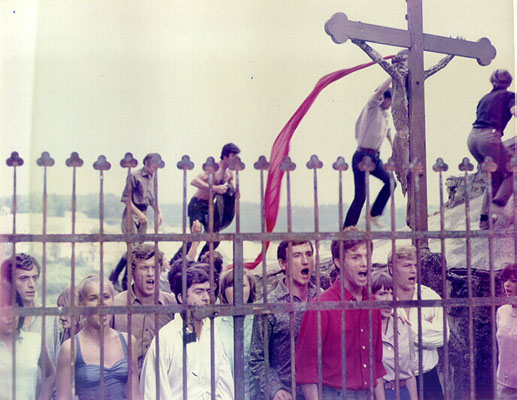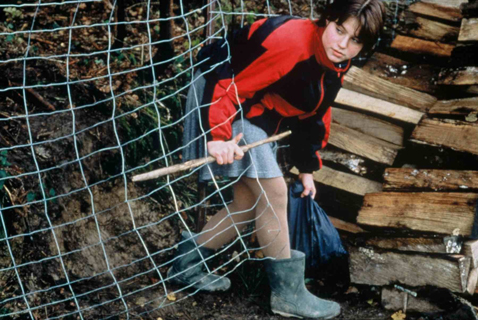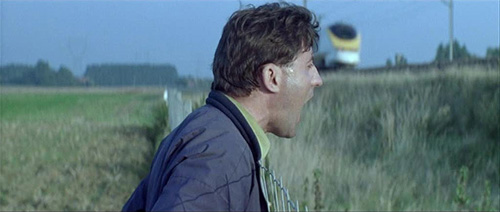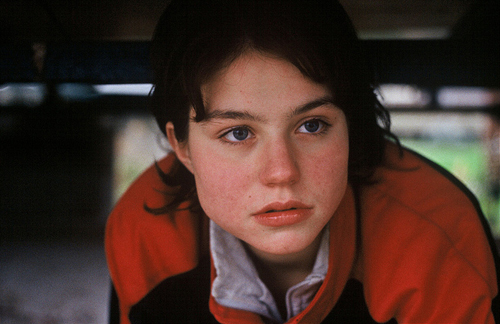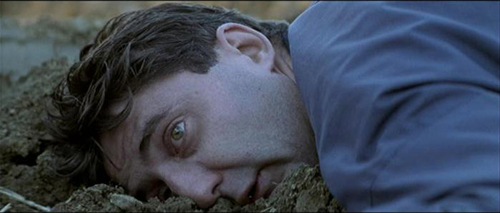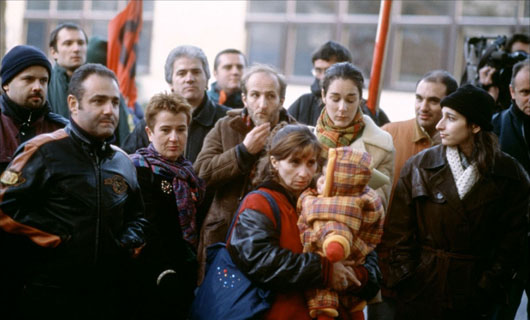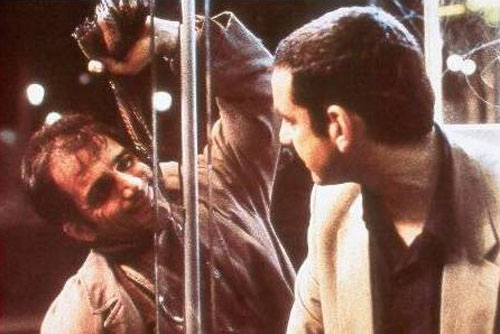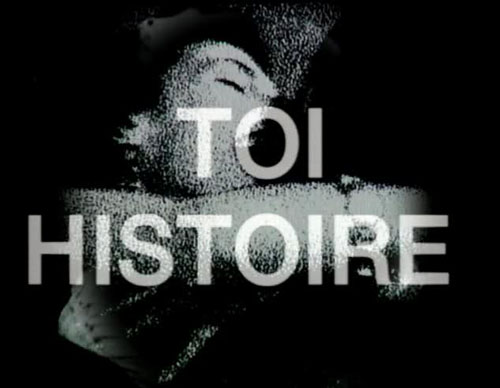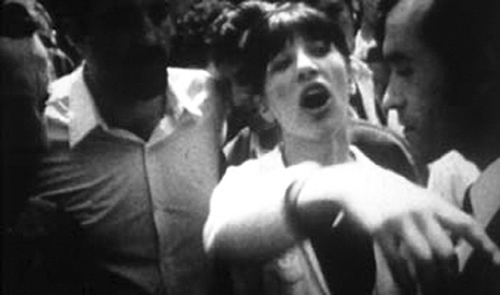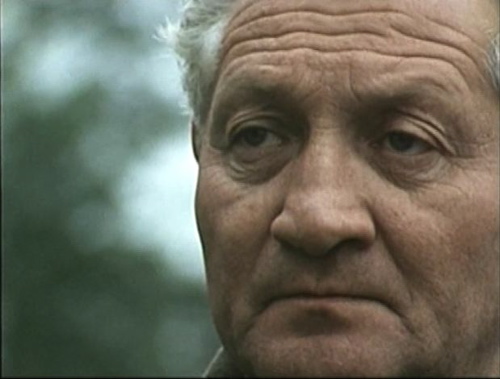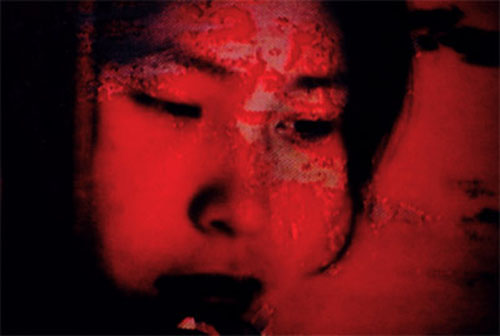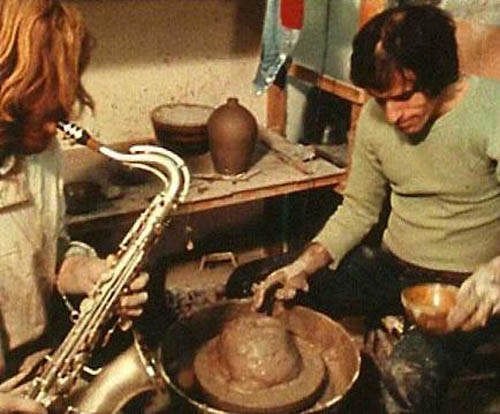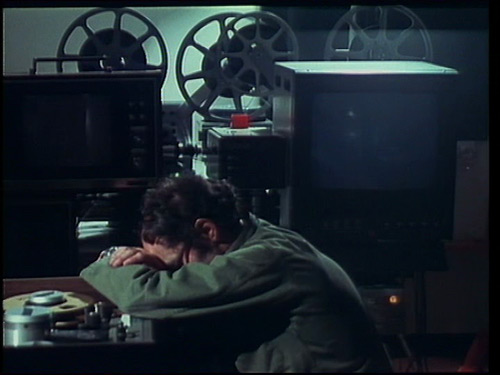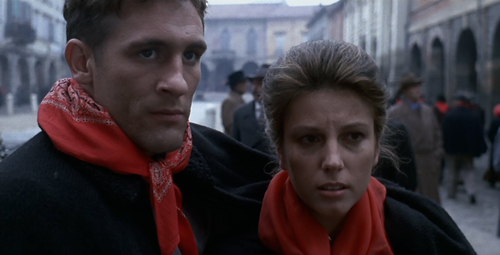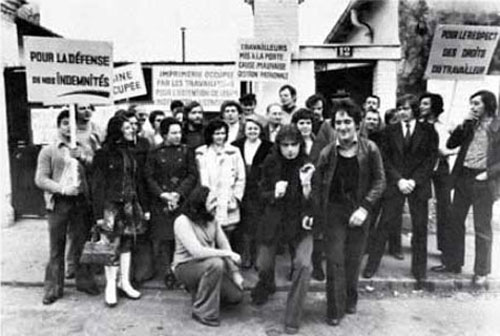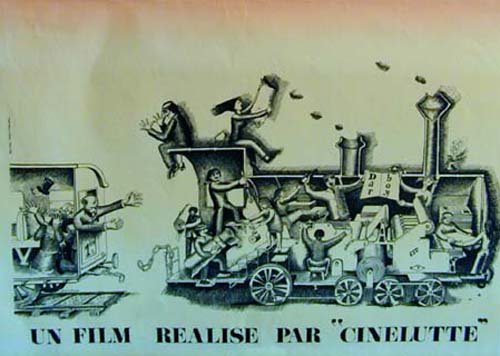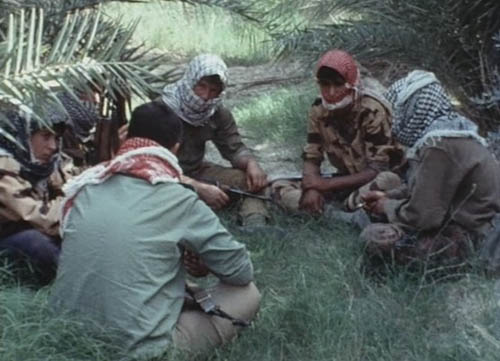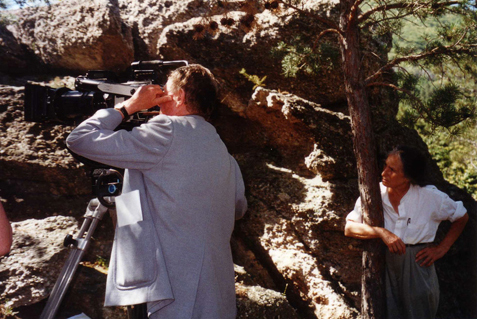
Jacques Rancière, Philippe Lafosse and the public in conversation about Straub-Huillet’s work after a screening of ‘Dalla nube alla resistenza’ (‘From the Clouds to the Resistance’, 1979) and ‘Operai, contadini’ (‘Workers, Peasants’, 2001) on February 16, 2004, in the context of a Straub-Huillet retrospective in Nice, France. Translated by Ted Fendt (2011). Found on mubi.com.
PHILIPPE LAFOSSE: It seemed interesting to us, after having seen twelve films by Jean-Marie Straub and Danièle Huillet and talked about them together, to ask another viewer, a philosopher and cinephile, to talk to us about these filmmakers. Jacques Rancière is with us this evening to tackle a subject that we’ve entitled “Politics and Aesthetics in the Straubs’ Films,” knowing that we could then look into other points.
JACQUES RANCIERE: First, a word apropos the “and” of “Politics and Aesthetics”: this doesn’t mean that there’s art on the one hand and politics on the other, or that there would be a formal procedure on the one hand and political messages on the other. I will define these terms first. Politics is certainly ideas about the way to organize a community, but it’s also a real community, a certain distribution of spaces, bodies, words, capacities… As for aesthetics, it isn’t form. I would say that, there too, it is a visible distribution of time, spaces, bodies, voices… A film by the Straubs is always a way of placing bodies that recite texts in a space; bodies, texts and spaces being almost inseparable. A film by the Straubs is always characters who recite texts: none of them speak in a traditional manner—in order to express feelings, for example—or in a reaction to fictional situations. They recite texts and sometimes in the most radical of ways, like in Workers, Peasants, with a notebook in front of them. These texts are strong, literary texts, thus never sketches, never scripts. The people always recite texts that talk about community, power, people, property, classes, the shared world, and communism. Also, what I, the spectator, see in a film by the Straubs is a mise en scène that is always a mise en commun of bodies and texts, texts that concern these bodies themselves. The Straubs reject everything in the order of mediation, what happens through story, characters… Traditionally, a political film is a film where you are lead to make political judgments through stories, situations, characters’ reactions to events. Now, there is never anything like that in their films. For them, everything must be present in the relationship of bodies to these texts that talk about ordinary things. They also exclude all forms of representation, representation in the sense of a relationship between something that is there, present, and another thing that is elsewhere, absent, represented by what is there. That does not mean that there’s no absence, even if it seems to me that there is less and less in their films. When there is absence, it can be said to be inscribed in the shot itself, in the film itself, and that it is never situated in a supposed “inside-outside” relationship: in Othon, to only take one example, the absence of the citizenry is in the film itself. After all, there is always a privileging of the direct, the present, which is marked in the treatment of time and space, in the treatment of the texts: space and time are always real spaces and times. To put it differently, they are never presented as fictional constructions and the characters say their texts over the noises of cars, insects, or variations in the light, of the air with time… Workers, Peasants is, from this point of view, exemplary of their methods: they remove blocks from a text that are theatrical blocks, blocks of dialogue. In this instance, these blocks are lifted from a book by Elio Vittorini, Women of Messina: these are four chapters of an eighty chapter novel, a novel made of assemblages and using different types of narration. In the book, these four blocks are stories that the people tell to someone who was absent from the community during winter. The entire context disappears in the film so that only the stories remain. In general, the modifications that the Straubs bring to the texts are very limited, but we can say that they consist of two kinds. Firstly, and this is also exemplary in Workers, Peasants, one goes from prose to a type of versification: with the actors, they transform Vittorini’s prose, which is written in continuity, into verses. Secondly, they always go from an indirect style to a direct style: for them, there must never be quoted words, they suppress everything that is in the third person, quoted voices or narratives, they don’t tolerate such things. There are never stories, but only dialogues, meaning uniquely words that are words performed and always kept in the first person. From which maybe sometimes come certain problems…like in From the Clouds to the Resistance, adapted from César Pavese. While the first part, consisting of dialogues taken in blocks, is perfectly satisfying, to my eyes the second part is less so: in only wanting to keep what can be put in the direct style, they eliminate a whole part of the novel, which is essentially a flashback. And, in this case, eliminating what can’t be treated in a direct style is to my eyes regrettable because this has the consequence of narrowing the novel and concentrating on the explicitly political issues, such as the priest’s speech or the statements of the reactionaries at the bar, which ends up losing something from Pavese. But let’s say that it’s their point of view: they don’t like narratives, everything must be direct. With the notable exception, it’s true, of Not Reconciled and Chronicle of Anna Magdalena Bach.

LAFOSSE: That is the aesthetic position that, for you, proves a political position true…
RANCIERE: One could say that in general their dispositif (1) contains a bit of open-air theater, with characters that may be in togas or in ancient garb in an open space. And this basically reflects a certain type of political utopia: one might think of the public festivals of the French Revolution or the Greek theater as it was dreamed of during the German Romantic period. It’s the idea of a people’s theater. The people are both in the audience and on stage. There is a similarity between theater and democratic assembly. At the same time, there is this culture-nature relationship, this myth of the Greek theater as the city-state in the middle of nature, nature being both its location and its foundation. For the Straubs, there is always this relationship reflected between three things: bodies, texts, and what the texts talk about. And the texts themselves, what do they talk about? They talk about people, about nature, and the relationship of one to the other. There again, it’s particularly striking in Workers, Peasants where, precisely, the community is not in the past: these are stories and yet one could say that everything is in the present, one could say that the community remains in the present in the text that talks about it. I think they made this film in opposition to another film with a similar subject: Jean-Louis Comolli’s La Cecilia, a film from 1976 on a utopian community of Italians in Brazil who dissolve a bit like the community in Vitorrini’s book dissolves. There are outside events, new things, the newly founded Republic, and the community falls apart. Comolli tells the story, we see people leave, we witness their misfortunes, their contradictions, and we see, finally, how this crumbles. And that is what the Straubs absolutely refuse. In their films, the community may be done with, but it is always there and it will always be there. It’s like kinds of visible blocks of intensity that are always present and always in the present. That’s the overall dispositif of the political aesthetic in the Straubs’ films.

LAFOSSE: We were able to see the films they directed in the 1960s and 1970s as well as the recent films. Do you consider this dispositif to be found in all of their films, from Machorka-Muff to Workers, Peasants?
RANCIERE: There is most certainly an important evolution over time. I would say that, if an open-air theater is involved, we nevertheless pass from a one kind of theater to another: let’s say from Brecht to Hölderlin or, if you prefer, from a dialectic dispositif to a lyrical dispositif. This is a change of the dispositifs meaning that, I believe, is also a change of Marxism and of Communism between the films of the 1960s and their latest films. In the first configuration, what I’m calling the dialectic configuration, at the center there is a relationship of tension and opposition between words, what the words mean, and those who say them. I’m thinking in particular of Othon and History Lessons, films from 1969 and 1972. History Lessons is based on Brecht’s text The Business Affairs of Julius Cesar, a book that also presents itself in the form of interlocked narratives: supposedly living a bit after Cesar, the narrator goes to interview a witness, a witness who is getting rid of a manuscript of the freed slave who took care of Cesar’s accounts. Already at that time, and a bit like in Workers, Peasants, the Straubs made a selection: they take the dialogues, the characters’ discussion about Cesar’s career, etc., so that the film is a straightforward political lesson. Finally, these distinguished people, seated in a garden, make us understand that the logic of profit, the permanence of economic interests and class struggle underlies wars, revolutions, changes of leadership or forms of government. It is a straightforward lesson given across a series of processes of disassociation, gaps between bodies, texts and space. These dialogues borrowed from Brecht are recited by figures in Roman togas, who talk of Julias Cesar’s business affairs the way we talk about those of Jean-Marie Messier, except that they are in the garden of a villa in the present, arrived at by car. Moreover, their conversations are cut up by long sequences where people drive in the packed streets of Rome. A question: what relationship is there between traffic jams, the world, car horns, noise and the rest, between this contemporary urban city and the conversations in togas? It seems to me that there is an almost automatic distancing effect here. A game of current events is set up, a distance is created. It’s always the same and, at the same time, precisely, the distance is marked, the strangeness of this business is marked. After all, these car rides that have a pointless feeling are a way of miming the dialectic exercise. It’s a way of telling us to pay attention to the text, to those who recite it, and that it is necessary to learn to read reality on the model of the attention that one brings to the hazards of driving. It’s a bit of the same thing in Othon, Corneille’s tragedy recited in its entirety and recited on Mount Palatine, in the ruins of ancient Rome that overshadow modern Rome. It’s based here again on a system of gaps in the topography and gaps in the diction of the text. At the topographic level, first… This tragedy about clashes for power after Nero’s fall, this text, in sum, about Rome’s destiny is filmed on Mount Palatine between two Romes that are both absent: one is only ruins and the other is below. In most of the film, we hear, sometimes we discover, far below, modern Rome, with its cars and aggressive noise.

LAFOSSE: A modern Rome that has nothing to do with all these stories…
RANCIERE: Also, you could say that the text is situated in a space presented twice as inadequate. If we consider the diction of the text now… We notice that it is said by mostly Italian actors and in a monotonous and accelerated manner, as if the overall meaning was more important than the exactness of the text. It’s very different than what we saw this evening. In Othon, the talk is fast, a part of the text is chewed up, and we understand well that it is a supplementary demonstration that all these beautiful words are after all great intrigues between them, distanced from the people, and behind their backs. In these films from the 1970s, the dispositif that I’m calling dialectic makes it so that the texts are directed by their differences—the collision of words and things, the collision of the past and present…the collision of the working class and the nobility. And this collision is supposed to have a revelatory function; it is supposed to show the contradictions inherent to social reality. We therefore have a theater for a spectator Brecht dreamed of: the actor in social conflict is supplied the means to read reality, given the knowledge of what the words mean and so on. It is political cinema that operates the basis of demystification, of unmasking…of disrespect, and that allows a certain state of the world to be understood, meaning the state of the class struggle. The second dispositif, that we find later, for example in Workers, Peasants, is in my opinion completely different, even if there are still rather immobile bodies in a large, natural space. In Othon, Corneille’s text was sort of made into prose. Now, what is striking in Workers, Peasants is that there is, instead, a sort of versification of Vittorini’s text, like a desire to magnify each word, almost every syllable, and this is notably thanks to a kind of over-articulation. I would also say that their recent films substitute the dialectical dispositif of the past, made of disagreements and disassociation, with a lyrical dispositif of agreement between text, body, and place. In regards to the story, for example, it is now no longer about revealing the more or less seedy reality of the business affairs of the elite, but it is now about demonstrating in a directly visible manner the way in which people deal with their own business affairs. At its core, it is about directly demonstrating the power of a communism that is not a goal to obtain by arming oneself for a future battle, which is also not a past, nostalgic episode, but that is already and still here, and that, in a sense, is here forever. Therefore, there is a dispositif of agreement between what is said and the words that express it: we are no longer in the dissociation between words and the visible but rather in the relationship between equality itself in the visible—that is there, this stays, this continues—and speech, both dramatic and lyric. By dramatic speech, I mean words exchanged by characters in conversation. The construction of Workers, Peasants is remarkable from this point of view. Groups oppose one another: workers and peasants, leaders and masses, men and women… Each speaks in turn, lays out his or her problem. Each is in his own shot—it is very rare in the Straubs’ films that partners in an exchange are in the same shot; when they are, it’s generally from behind. Each one reads his text or looks at it or looks in front of him in an undetermined direction. None of the characters look at those that they are talking to. It’s like a kind of absolutizing of words, it’s as if everything was in the words. And these discussions between workers and peasants, between leaders and masses, between men and women, between the faithful and deserters, etc. are not heartrending dramas like in Comolli, for whom these conflicts are dissociated elements; in the Straubs’ films, these are, to the contrary, elements of consistency. This communist people exists. It exists in its own division and, at its core, by its capacity to affirm the division.
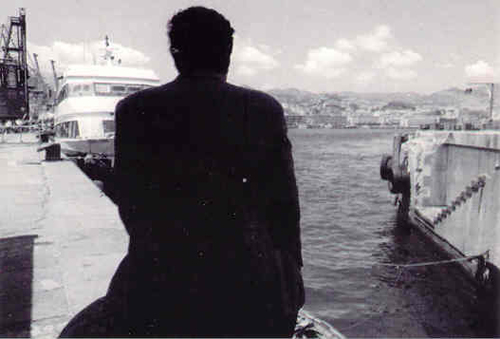
LAFOSSE: Ah, dialectics…
RANCIERE: Yes, we find there their dialectical side. For there to be a community, it must be divided. One exists by two. And it is dramatic speech that speaks of this division, but not in the style of a story because they don’t recount: they declare. Thus to declare is the occasion to demonstrate capacity for communism, to begin by an ability to speak. And, on this subject, what is remarkable is that the working class characters are played by non-professional actors who do not speak a working class language: they speak a kind of poetic language, it’s practically Virgil. In such a way that there is something like a game, something like a jumbling of hierarchies. The more humble the characters are, the more grandiose their language and tone. Think of the widow Biliotti, a country character played by Angela Nugara, who plays the mother in Sicilia!: she incarnates the nobility of the poor, a nobility of speech, an ability to elevate herself and to speak by bringing the greatest attention to language itself. There is nothing of a working class language; it consists, on the contrary, of a magnification. We can think of Carmela too, the one who does the accounts in Workers, Peasants and who says who leaves, who returns: everything is performed in her mouth; we constantly see her try to be at the height of the situation by her speech. We have before us the affirmation of a capacity for elevated language. And, as this speech is deployed, I would say that we pass from the dramatic content—in the sense of the exchange of arguments and disputes—to a common lyric power of words that affirm the community as it is. This culminates in the Ricotta episode and the episode of the departure to go looking for laurel, which are such great utopias staged through speech. Let’s take the Ricotta episode… She tells how it is made, how they come together around her, how it is shared, and we see that all the power of the community is put in three things: first, the savoir-faire, in the sense that, for the Straubs, there is a peasant savoir-faire that is opposed to a vision of socialist engineers or technicians; secondly, the grandness of the ceremony of sharing to which this savoir-faire leads; thirdly, language itself. This is interesting because an elevated culture—which is the culture of speech or based on speech—is often opposed to a working class culture—which is based on gesture and artisanal, manual savoir-faire. Now, here, this opposition is refuted absolutely: the same power is in the Ricotta and in the speech that talks about this Ricotta. There are no working class arts and, opposite them, bourgeois arts or arts cultivated by speech, but a shared intensity to words and what words says. At this moment, communism becomes an intensity, a degree of intensity of perceptible experiences. There is equivalency between Ricotta, sharing, and eloquent speech. It’s almost the same thing in Sicilia!, when the mother evokes the past. She is seen preparing her small dinner, there are long shots of the fish cooking, then she gets up and starts to talk of the lovers she has had, evokes the grandfather who was socialist but who nonetheless led the St. Joseph’s Day parade, and all of this is like a kind of working class grandeur that is found at all levels: in savoir-faire, in language, in storytelling, in tradition. But let’s go back to Workers, Peasants: there, Ricotta is like a communist Eucharist…like a consecration of the community. And I believe that that is an illustration of the reversal of the Straubs’ initial dispositif: the dialectical theater of the past becomes the theater where the dialectic is judged for its pretension to judge. Let’s look at Umiliati, which is in a way the sequel to Workers, Peasants, and let’s examine its dispositif. These are also short extracts from the end of Vittorini’s book—if it is only from there—it’s the end of the community, the moment when it explodes, through contact with the outside. A more or less enigmatic character who serves as prosecutor explains to the people that the world is a world of properties and that, consequently, they do not have the right to settle like this on a small bit of earth in order to make a community. There are also three characters, who are hunters in Vittorini’s book and partisans in the Straubs’ film. And the prosecutor and the partisans explain to the others that they are rather backward: together, they form the tribunal of history. The partisans are comfortably set up in the shade, in the ravine, while the members of the community are up high, under the sun, filmed like prisoners about to be executed. They teach them the lesson, they explain to them the laws of the economy like Brecht explained them in The Business Affairs of Julius Cesar. Except here the mise en scène itself refutes these economic laws. Visually, for example, it is apparent that this discourse and these lessons bore the peasants, the worker peasants of this commune. You can see how much the mise en scène refutes them, in the smallest gestures, such as that of the old peasant who lends a hand when another is speaking in order to finish off by simply saying, “Here, it’s another affair.” What other affair? We don’t really know, but a distance and a refutation are created, a refutation of the triumphant discourse of the laws of history and progress. Likewise, when the one who I’m calling the prosecutor explains these rules to them, it is a speech worse than a legal speech, and he delivers it with a wild look and a ventriloquist’s manner of talking, which makes what should be a brief statement become a funeral dirge, so that the dialectician clearly refutes himself. And then there’s obviously the last shot: Siracusa, the leader’s companion, is prostrated on the doorstep of the house, her head in her hands, it’s over but, when the camera lowers, her hand becomes a tight fist. That is a final gesture, a final image that comes to refute the tribunal of history.
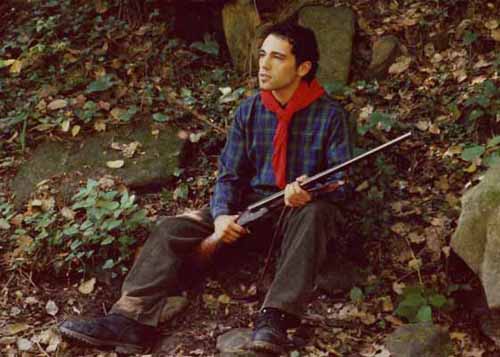
LAFOSSE: Space plays a very important role in the system the Straubs set up…
RANCIERE: We can talk a bit about that if you want. What is striking in Workers, Peasants, as in their latest films, is that the place of the characters is more and more nature itself. First, nature is the subject of the discussion—hence the argument in Workers, Peasants: on one side, there are workers and what one could call the soviet ideology that wants to put nature to use, to make roads, to transform it and so on, and to order total mobilization, and, on the other side, one finds peasants, those who agree on the time of germination, of waiting, of the harvest, of rest, of respect for the earth. That is the first aspect. Next, there is nature, which is before speech, and which eventually gives up its place and its power to speech. It’s what is there, what is always there without reason, before all reason, and what does not stop acting, reproducing itself and altering itself at the same time. From which comes the importance of the continual agitation while the men and women are talking: nature doesn’t stop moving. These are insect noises, bird songs, the effects of light on the plants, the trees, on the moss-covered rocks and the dead leaves… The activity of this undomesticated nature is constant. You’ll note that we’re talking about a peasant community but that at no time do we see it in the shot, for example: this is clearly voluntary. The partner is the wild nature, the ravine, undomesticated nature; and, after all, communism, for the Straubs, in this last part of their work, must necessarily be linked to a nature without rhyme or reason. There is also a dispositif that pronounces a rupture with the idea of nature that accompanied Marxism for a long time: nature as transformable material that man must model in his image and the idea of history as the humanization of nature. One could say that, now, the Straubs’ politics and mise en scène stands up for a certain inhumanity of nature. Nature is like a continual power and rumble that limits humans.
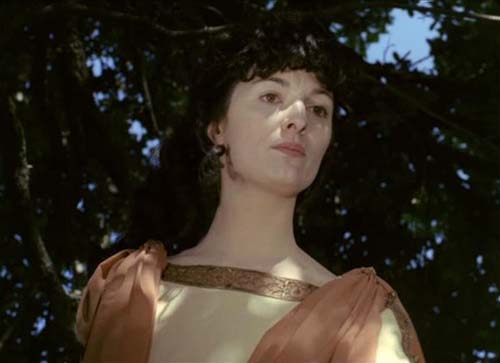
LAFOSSE: In your opinion, this change, this reversal can be situated at a precise point in their work?
RANCIERE: I would say that the film that is the turning point is From the Clouds to the Resistance, a film from 1978 adapted from Pavese, that I’ve already talked about and that has two parts: first, six of the Dialogues with Leucò, then very selective extracts from The Moon and the Bonfires. I believe that this meeting of the Straubs with these Dialogues is very important. Pavese wrote Dialogues with Leucò early in the post-war period, at the time when he rejoined the Communist Party and when he was writing a novel to announce this conversation, The Comrade. But, while rejoining the Communist Party, Pavese took a considerable theoretical distance not only vis-a-vis contemporary political and social events, but also from the technical tradition of Marxism. Thus, what he wanted to do with Dialogues with Leucò was to root what had been fascism, war, resistance, and communism in a much older drama of the relationship between culture and nature. This is why he went and looked at ancient mythology and, basically, what he recreated is a drama about the origins of tragedy: we can think of the original proceedings of Greek tragedy with the quarrel between the old and new gods, the establishment of justice, the passage from a maternal time—of the time of mother earth, the titans, the monsters—to the order of the Olympian gods. In 1978, the Straubs directed these six Dialogues with Leucò on the theme of the creation of a universe of justice and, consequently, on the time of the differentiation of gods and men, on the end of the religion of the earth. But, while they directed these dialogues, I believe that they placed themselves in a drama that marks their political aesthetic more and more. At this moment, the relationship of bodies to space becomes more and more this relationship to an inhuman nature, an inhuman nature that is the basis of another idea of culture. We move to a peasant or ecological communism, opposed to the communism of Soviet engineers. After all, this nature has no pastoral qualities. It is an ancient nature: a play of forces, a play of conflicting elements. One thus finds in their work what one could call an ancient philosophy of the elements of nature—water, earth, fire, air—and their conflict. To put it differently, with this film in 1978, there is a division between the heavy elements—water, earth, elements of heaviness, duration, secretiveness, waiting—and the light, volatile elements—brightness, light, elevation, air and fire. In a sense, Workers, Peasants is a discussion between men of fire and men of the earth, and everything plays on this war that also takes places in this setting. All the elements intervene all the time. You can think of the roles that water and air, insects, and wind play, the role that fire (meaning the sun) plays. The film is a war of elements that arrives at a reconciliation: the story of the Ricotta, the story of the fire, how to make the fire… The reconciliation of the elements is conceived as an apotheosis of the community, knowing that, at the same time, nature is also what is there before all arguments, as what is nameless. That’s why I say that for me, at a point, there is in their films a reversal of the dispositif between two communisms and two mise en scènes. In the first period, what was important in their work was the power of words over images—think of Moses and Aron, with Moses as the man of words and Aron the man of images, and the Straubs who, in this conflict, are on Moses’ side—and, this period is followed by a lyrical model where the power of what precedes words affirms itself over words, when something unnameable appears that gives words their meaning, all while imposing on them a form of respect. I have voluntarily opposed these two models in a rather blunt manner here, but I think that this opposition exists.
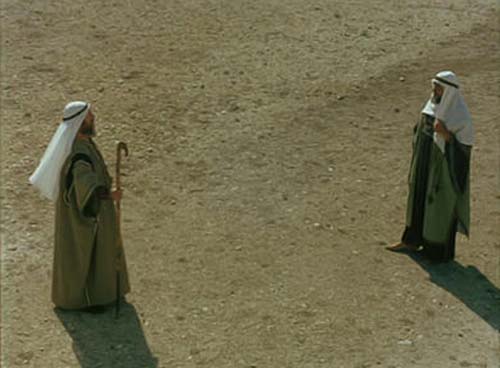
LAFOSSE: What you’re saying, and what you’ve shown with these examples is that at a certain moment, there is an ideological reversal for the Straubs: they move from a worker’s communism to a peasant’s communism, they move away from a Marxist dialect à la Brecht, to get closer to a “defense of the earth” communism.
RANCIERE: That’s the general context, but when I say that there is a dialectical model and a lyrical model, or a model of dissociation versus a model of agreement…at the same time, of course, the mise en scène only exists in so far as it works these two logics. And, there again, one could say that films like Workers, Peasants and Umiliati are a way of putting these two logics in the same space. In both, there is this play between a dramatic, dialectical dispositif of exchanges and a lyrical dispositif of affirmations…
LAFOSSE: And of movements of nature, as if everything was also in agreement: the respiration of the men, the vegetation and things.
AUDIENCE: You’ve talked about singing, but never of operatic singing, while sometimes there are poses that could make you think that the Straubs think of themselves like that. Is the presence of singing a new element in the Straubs’ films or has it always been there?
RANCIERE: If we talk about the direction of the music, in the literal sense of the word, it is certain that music has always been present in the Straubs’ film. Proof of this is that the first film of theirs that was seen—even if it isn’t the first that they made—was Chronicle of Anne Magdalena Bach, in 1967. Then, in 1974, there was Moses and Aron and, in 1996, From Today to Tomorrow. Thus, there is a very strong relationship with music. But, to respond to your question, we also note a stronger and stronger relationship to a form of total spectacle. I talked in regards to them about the Greek tragedy as it was thought about during the Romantic era, and we know that at first, opera wanted to be a recreation of Greek tragedy. This idea of a total spectacle is there, a complete spectacle that is a hymn. In regards to their films, you could therefore talk about operatic qualities. To this is added a displacement of the status of speech itself, an obvious displacement when you see Othon—with its delivery and way of talking that make it so the close relationship between language and speaker does not exist at all—and Workers, Peasants—where Vittorini’s sentences are treated like tragic verse, indeed as an operatic element. In this sense, there has also been an evolution and you could say a new element.
AUDIENCE: In Workers, Peasants or films like that, the actors sing the text…
RANCIERE: I wouldn’t say that they sing the text. They don’t sing it literally, but let’s say that they utter it in the fashion of poetry which implies the idea of singing: in the vein of lyrical poetry. The reference to a language that would not separate prosaic speech from song is very present. In that film, one finds the utopia of the Romantic period when speech and song formed a primary entity.

LAFOSSE: Over the course of these days we’ve thought about the coexistence in the Straubs’ films of materialism and spirituality. Could we address this question?
RANCIERE: It’s a bit complicated and rather dangerous. Basically, in their work there is a kind of radical materialism in the mise en scène that wants to eliminate every representational element and that wants everything to be shown, direct, present. And there is equally an idea of communism as an entirely material matter: in the place of relationships of production and productive forces, there is the Ricotta, snow, ice, stars… So there is this aspect that can be qualified as materialistic. But, at the same time, this materialism recalls the dream of the Romantic era (and that’s due to their proximity with Hölderlin and German Romanticism), meaning to the idea of a world where there would no longer be on one side the intelligible world, thought, and law and, on the other, the visible world, but a world where a common law would be incorporated in the visible world itself and where there would no longer be any opposition. This is what gives the Ricotta a Eucharistic quality, a desire to transform everything—gesture, human speech—into a sacrament. In a way it means uprooting sacraments to the heaven in order to now consecrate human bread and blood in place of the bread and blood transformed by the son of God. It is in this way that a materialism that is not against idealism, against spiritualism, is found in the Straubs’ films. There is also a second aspect that responds to this question but that, for me, is less interesting. It’s an aspect that’s a bit provocative and fashionable: you constantly are meeting people who explain that Marxism is religion, that Brecht was Catholic and Claudel a materialist… For me it’s a game, a rather simple reversal and, if it occurs to the Straubs to sometimes concede this, it remains secondary. What is essential in my eyes is really the refutation of the opposition itself that we talked about, it’s the fact that the spiritual is found entirely in the gestures, in the consecration of gestures. It’s the fact that thought is entirely found in the materiality, not in the Soviet vein of transforming of the world by thought, but by a realization of thought as in accord with the rhythm of nature.
AUDIENCE: Aside from the question of the opposition between materiality and spirituality, what I found interesting in their work is that there is maybe a mystical approach which leads them to do radical things, including in the vein of representation and form.
RANCIERE: There are different ways to overcome an opposition. One can overcome it by the classical model of thought that realizes, that transforms the world in its image, or by an inverse model of thinking that puts itself in agreement with nature. I don’t know if you can call that mystical. What is certain is that it is a matter of going back to a religion of the earth that existed under diverse forms during the Romantic era. The Straubs’ Marxism has more and more of a tendency to move towards Heidegger and to distance itself from the Brechtianism of thirty or forty years ago.
AUDIENCE: I remember in a film a scene of a supposed fusion of the hero with nature, with the stars. But the way in which the Straubs talk about the stars has nothing to do with the way in which Goethe, Novalis or Hölderlin do. For Goethe, Novalis, and Hölderlin it is always upward, while there, to the contrary, it’s downward: the hero sees the stars almost below, it’s absolutely amazing…and there is nothing inseparable about it. The relationship with nature is not inseparable at all. Also, I agree with you when you’re talking about another relationship to nature—fire, not electricity—, but not when you talk about fusion with nature. It’s also for this that the relationship with German Romanticism, it seems to me, needs to be used with a bit of precaution.
RANCIERE: It isn’t me who’s making this relationship, it’s them. It’s maybe not your Hölderlin, but it’s theirs. As for the fusion, I would say that it is without a doubt more at the level of the relationship between nature and culture than at the level of an inseparable relationship of men with nature. The fusion with the stars is one thing. But what is at the heart of German Romanticism is the idea of a visible world that would no longer be opposed to an intelligible world. And it is this idea that the Straubs take up, the reference to Hölderlin being massive.
AUDIENCE: But Hölderlin isn’t a Romantic!
RANCIERE: You can say of anyone that “he isn’t a Romantic.”
LAFOSSE: A question of fusion, and even if Hölderlin’s Empedocles is unfinished, his goal is nonetheless to melt himself in the volcano, and totally. At its heart, it is also a question of that kind of fusion.
RANCIERE: Yes, of course.
AUDIENCE: Don’t you think that the connection you’re making between the Straubs and Heidegger distances them from any idea of progress?
RANCIERE: From progress surely, but they are deliberately anti-progressive! They want to be in this anti-progressive revolutionary tradition, in the way Benjamin criticized progress. They are developing an idea of progress completely at odds with an idea that would inscribe it in the continuity of the development of the sciences and social relationships. There is a “back to the earth” quality, in their work. This is seen in the layout itself, in the distribution of characters between high and low, between light, brightness, and appearance, and withdrawal, the earth… And this is a dramaturgy very close to Heidegger, a dramaturgy that corresponds to a certain form of contemporary thought that draws from Hölderlin a model of revolution and communism separate from progress. You may find this paradoxical but they take up this paradox with the same willfulness that Benjamin had in breaking the course of history and advocating a return to the past. Like Pavese going back to myths to re-interrogate and question the relationship between nature and culture in order to re-situate and re-think communism, the Straubs are radically isolated from the tradition that links communism to Enlightenment thought, progress, and scientific development. They demand it.
AUDIENCE: When one talks about progress or development, it is important to know what one puts into those words. What is progress and development in the Western world? Today, these are things that are questioned, outside of all dogma, and including by those who want to be considered progressives. It seems important to me to add nuance to it and say that the notions of progress and development do not come down to certain harmful models that wanted to be imposed as universal standards. The progress of knowledge is not necessarily the progress of techniques, the ravaging of the quantitative and the increasing of production!
RANCIERE: In the strongest sense, progress is the idea that all developments work in unison. If we leave behind the rather ordinary usage of the term “progressive,” meaning someone who is rather to the left, on the side of the people and for justice, if we try to give a more precise meaning to the word, progress means an idea of history as going straight forward and with all developments contributing to one effect. It is this type of progress that is at the center of Marxism.
AUDIENCE: Maybe, but that doesn’t sum up progress, progress doesn’t reduce to that!
RANCIERE: No, but it is always necessary at a given moment to make summaries. One makes choices and, when one makes choices, one makes summaries. It’s what the Straubs do in this case.
LAFOSSE: You’ve talked about story, about narrative. You say that plot never really interests the Straubs. On the choices precisely, there is something striking in their work: the position of the bodies in relationship to the narrative. The narrative advances through the bodies but at the same time there is a force that could be qualified as a refusal. In their films, don’t the bodies also go against the narrative?
RANCIERE: Bodies put everything that is narrative in the present. Said differently, they appropriate the text. In Vittorini for example, there are people who, in contrasting manners, tell what happened to them over a period of six months. But in Workers, Peasants, that’s not what it is: there are groups who confront their past and this past is absolutely present. So, basically, the bodies are there, upright with their text, with the reasoning of their arguments, and, as they speak, everything that was narrative, becomes direct speech, dialogue, affirmation. This doesn’t mean that they make the past into a blank slate, but the film is always in the present tense. Also, bodies take possession of the text, putting it entirely in the present tense. If we don’t forget that, fundamentally, narrative doesn’t interest them, that they don’t want that, and that, everywhere that it is, they eliminate it—as in From the Clouds to the Resistance with the examples of the flashbacks that I was talking about, a flashback necessarily being narrative—, well, you realize that speech has to unceasingly re-conquer its power over everything that puts it in the past tense, that makes it not current, outside of reality. Of the narrative. And, as you said, bodies that take possession of the text through speech are therefore also going against the narrative.
AUDIENCE: Can one not think that everything must be in a film and that a film doesn’t have to need ulterior explanations?
RANCIERE: It’s a choice. What is a film? A film is something that one sees like this, that one sees once and, often, it’s over for a long time. A film is an extremely volatile object that does not necessarily need to constantly be explained or commented on, but extended. In any case, films continue to live within us, even without commentary: we make our own commentaries on them. In eight or ten days, this film that you have seen this evening will become another thing. Shots, words will leave; a new film will be constructed. You can’t ignore this extension. Memories of films are not uniquely memories of what has been before our eyes at a given moment. Memories of films are memories of everything that, afterward, gets buried. The cinema is made of this sedimentation. Also, if I don’t think that films have to be explained, I believe that one can try to extend them outside of all commentary, interpretive aims. Cinema needs to have created for it a space for speech that is a space of sedimentation: that’s the role of talking about films. Personally, when I see a film, I want to read the things behind it. Not to explain it to myself, but so that it resonates differently, so that other connections are created, so that the film is made to live in a larger space.
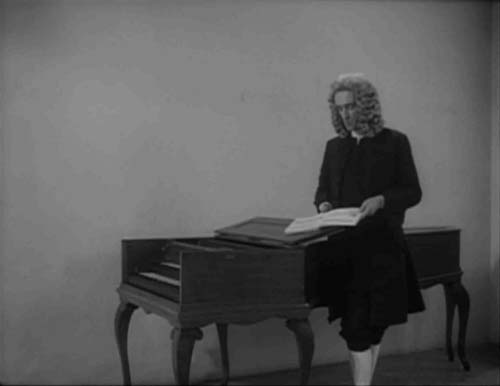
LAFOSSE: This extension through words is something very present in the cinephilic tradition starting at the end of the 1940s and the beginning of the 1950s. If we look into everything that made up the New Wave, we see that for those filmmakers it was indispensable that there was, after the film, an extension via words that could be even more important than the film. It was the period of film clubs, of repeated viewings of films. To associate vision with talking is something that is linked to cinephilia, which was part of the resistance, a counter-cultural network, and a parallel society, places where one thinks and debates as well. And that was a discourse that was not really on the level of explanation but in the order of exchange and of another life for the film. Films don’t die after the words “The End,”—for them, at least, I’m sure of it. Outside of their body, they can still unfold.
AUDIENCE: I think that this is part of this genre of films. The Straubs’ films are made to be thought about and to incite people to think. You think and afterwards you talk, it can’t stop there. It’s made for thinking.
LAFOSSE: To think, to feel… The fullness of the idea in the colors: it’s what Cezanne says of Véronèse.
AUDIENCE: I’m discovering the Straubs here. And I’ve asked myself about the place of children in these films because the only one that I saw was this evening in From the Clouds to the Resistance and I have the impression that they were embarrassed to film him, a bit like Godard. Could you talk to us about their experience with children? Are there many of them in their films?
RANCIERE: There aren’t a lot, and it seems to me that there is no problematic of childhood. There are two children in From the Clouds to the Resistance because they are in Pavese’s book and his novel is also a story of transition, transmission and passage from an old order to a new order. In The Moon and the Bonfires, there is the story of the deformed boy, and that of the father and son, where a relationship between an old world and a new world is expressed, and where the child brings a negative judgment on humanity, and in En rachâchant, a film from 1982, a child resists his teacher… Does this mean that there is a child figure in the Straubs films, indeed a figure of resistance? Never forget that they work from texts that are addressed to an adult community to ask it where it is with itself, with its past, with its future and, if there aren’t children in these texts, there aren’t any in the films. It happens that the child serves certain questions but it is rare that he is really put in the foreground and treated as a character. For the Straubs, the child is not the future of the world.
LAFOSSE: Would you say that this cinema treats a sort of lost innocence?
RANCIERE: Can one speak of innocence? Maybe. There again, from the turning point that is From the Clouds to the Resistance, we notice a nostalgia for a certain innocence, not in the sense of lost purity but of a world before good and evil. It is present in Pavese and even Hölderlin: there is a confrontation with a world in which the gods no longer exist; there is a relationship between man and nature before the division of good and evil. This could be called innocence in the sense that Nietzsche talks of the innocence of becoming, of a world that is beyond good and evil. However, I’ll say it again: the Straubs’ nature is absolutely not a pastoral nature, it is savage, worrisome, cruel and inhuman. It is not idyllic.
LAFOSSE: We’ve sometimes asked here how we’ve come to the Straubs’ films… Can you, Jacques Rancière, tell us how you came to their films?
RANCIERE: A bit in a zigzag. I first saw Chronicle of Anna Magdalena Bach when I was young. I was happy to see it but I can’t say that it marked something specific in my life. After that—it was the period of an extreme left—, the people at Cahiers du cinéma recommended I go see History Lessons. I’ve always had a bit of an imposed relationship with the Straubs: “go see it and come talk to us about the Straubs,” they’d say to me. So I saw History Lessons for the Cahiers and I remember that it rather depressed me. It’s true that next I immediately loved the magnificent way that they treated Dialogues with Leucò in From the Clouds to the Resistance: it’s fabulous. Even if I continue to hold it against them for, in The Moon and the Bonfires, completely avoiding the three girls who are the body of Pavese’s novel and having instead made a sort of easy bit of anti-clericalism by giving a spectacular visualization of a priest’s speech that is only mentioned in the book. At other times, I saw a film that I liked, then films that I didn’t like at first but that I liked afterwards. Let’s say that I saw in a rather chaotic manner certain films at very different moments, without at all feeling myself to be an aficionado of the Straubs. And then, two or three years ago, some young, fanatical Straubians told me they wanted to unite their two passions by hearing me talk about the Straubs. To do this, they sent me to see Workers, Peasants so that I would talk about it at a philosophy convention in Nantes. I went to see it, saying to myself that it wouldn’t necessarily be very amusing, but I was seized by its lyrical power. I talked about it, this pleased the Straubs. And there you have it. Afterwards, I was asked to write about Umiliati and Pedro Costa’s Where Lies Your Hidden Smile?. So you could say that I found myself as an accidentally inundated specialist of the Straubs. There are things that I love tremendously in their work, there are other things that I like less, and, finally, there are films that I don’t like at all. In any case, I didn’t have an epiphany with their films, I had a relationship spread out over time with considerable variations in approach and feeling. And I’m trying to talk about all this.
——————————————————————————————————————————————————————-
See also this film made on the occasion of the Straub-Huillet retrospective in Paris (November, 2007 – March, 2008), organised by Philippe Lafosse.
And this debate with Jacques Rancière after the projection of Europa 2005, Joachim Gatti, Corneille-Brecht and O somma luce, in Paris, January 2011.
